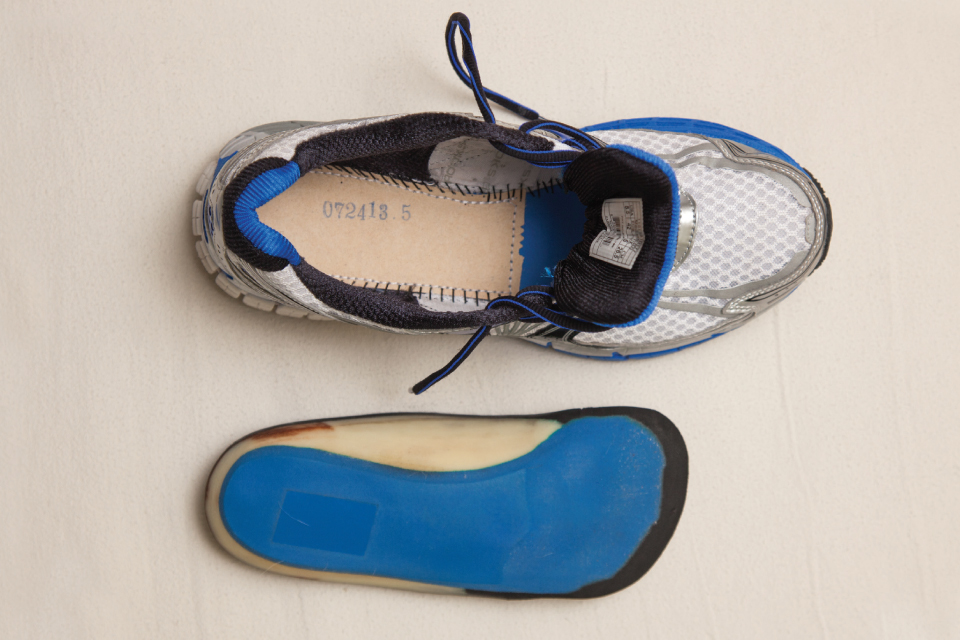Are Custom Orthotics Right For You?

In the world of orthopedic rehabilitation, a debate rages regarding custom foot orthotics. The debate (though slightly less intense than the one about minimalist shoes) is about what orthotics actually do to help patients that other traditional treatment modalities cannot accomplish. Are they being used to take the load off of or support a painful structure? Are they directly or indirectly changing the mechanics of the foot or other lower limb joints? Or are they generally making positive, holistic postural or gait changes?
You will likely get a dozen different answers from a dozen different practitioners regarding what an orthotic really does and how an orthotic should be made. Consequently, there are many different styles of orthotics constructed from a wide variety of materials (foam, plastic, leather, and rubber) with different textures and densities. Orthotics are also cut to different lengths (from heel to toes, heel to just behind the toes, or heel to behind the ball of the foot), contoured to shape around the sides of the foot and the heel or made almost flat, and constructed to be very rigid, very flexible, or anything in between. What needs to be understood is that all of these factors matter, and they matter a lot.
And, by the way, there’s even a silly debate over what we should call them: orthotics, orthoses, an orthosis, arch supports, or custom foot beds. For this article, I’m using the terms custom foot orthotics or orthotics, and I’m going to give my opinion, which has evolved over the years and is obviously biased. But it is based on much experience seeing what works and what doesn’t.
I geek out a bit on this subject. As someone who has been using custom foot orthotics in my practice for more than 20 years, I’ve gathered quite a bit of knowledge in a variety of ways. My patients bring in a lot of different orthotics; I often use orthotics with my patients; and I don’t go the custom orthotics route at all if I can assist in making positive changes in a more practical or cost-effective manner. However, there are many times when it’s perfectly clear that there are ongoing barriers to completely solving a patient’s problem, and sometimes the source can be found at the feet.
I’m a physical therapist, so I feel suited to looking at the whole patient and using orthotics to help make beneficial changes, not only for foot- or ankle-specific issues but also for making more general changes in posture and gait. For example, it may be clear to me through a series of tests that a patient is making compensatory changes in his or her hip position because, when upright or walking, his or her feet are consistently positioned in a way that makes it impossible to maintain an ideal pelvic and spine position. Thoughtful and careful design of custom orthotics can have beneficial effects on situations like this by supporting loose structures or stimulating muscles to work or relax at the appropriate time. Orthotics may also have a more widespread effect by causing subtle changes in muscle patterns throughout the body.
Orthotics affect the foot in essentially two main ways. First, there is a sensory response, or stimulation of nerve endings in the feet, that creates a motor response, which is a reaction of the foot and ankle musculature. In the bottom of the foot, there are more nerve endings per square inch than anywhere else in the human body. So the greater the surface area of the foot that an orthotic can affect, the more nerve endings can be utilized for a proprioceptive response. I believe an orthotic will have maximum benefit for my patients if it can contour to as much of the bottom of the foot that the shoe will accommodate.
Second, a custom foot orthotic should be designed so that the bones of the foot are aligned as close to neutral as possible when at mid-range of motion. The big toe, foot, ankle, knee, hip, and pelvis also should be lined up properly. This goal of neutrality, as with any joint, will also improve the effectiveness of the corresponding muscles and tendons. Of course, all joints move in and out of neutral, and an orthotic needs to be flexible enough to let this happen. But with the proper use of materials, an orthotic can provide the best of both worlds. Creativity in design and in the materials chosen is necessary when, upon evaluation, it is found that the patient’s foot is pathologically loose or rigid.
Lastly, there is one important point that seems simple but is often overlooked; an orthotic needs to fit into the shoe seamlessly. Custom orthotic design should be fairly precise, and it’s a shame when they don’t fit properly in the shoe. Unfortunately, I see this far too often.
If you look at the bottom of the inside of the shoe, there is a distinctive shape, and that shape needs to match the bottom of the orthotic as closely as possible, or the orthotic position may be altered or slip around in the shoe. Changing the angulation of the orthotic inside the shoe will completely change how the orthotic design is influencing mechanics.






